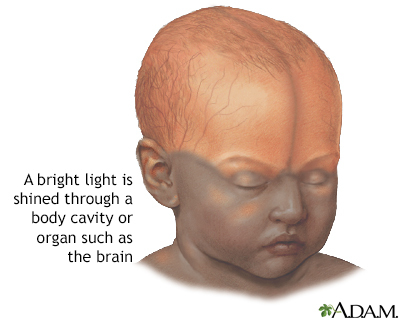Transillumination
Definition
Transillumination is the shining of a light through a body area or organ to check for abnormalities.
How the Test is Performed
The room lights are dimmed or turned off so that the area of the body may be seen more easily. A bright light is then pointed at that area. Areas where this test is used include the:
- Head
- Scrotum
- Chest of a premature or newborn infant
- Breast of an adult female
Transillumination is also sometimes used to find blood vessels.
In some locations in the stomach and intestine, the light can be seen through the skin and tissues at the time of upper endoscopy and colonoscopy.
How to Prepare for the Test
No preparation is necessary for this test.
How the Test will Feel
There is no discomfort with this test.
Why the Test is Performed
This test may be done along with other tests to diagnose:
- Hydrocephalus in newborns or infants
- Fluid-filled sac in the scrotum (hydrocele) or a tumor in the testicle
- Breast lesions or cysts in women
In newborns, a bright halogen light may be used to transilluminate the chest cavity if there are signs of a collapsed lung or air around the heart. (Transillumination through the chest is only possible on small newborns.)
In general, transillumination is not an accurate enough test to rely on. Further tests, such as an x-ray, CT, or ultrasound, are needed to confirm the diagnosis.
Normal Results
Normal findings depend on the area being evaluated and the normal tissue of that area.
What Abnormal Results Mean
Areas filled with abnormal air or fluid light up when they should not. For example, in a darkened room, the head of a newborn with possible hydrocephalus will light up when this procedure is done.
When done on the breast:
- Internal areas will be dark to black if there is a lesion and bleeding has occurred (because blood does not transilluminate).
- Benign tumors tend to appear red.
- Malignant tumors are brown to black.
Risks
There are no risks associated with this test.
Gallery

References
Ball JW, Dains JE, Flynn JA, Solomon BS, Stewart RW. Examination techniques and equipment. In: Ball JW, Dains JE, Flynn JA, Solomon BS, Stewart RW, eds. Seidel's Guide to Physical Examination. 9th ed. St Louis, MO: Elsevier; 2019:chap 3.
Lissauer T, Hansen A. Physical examination of the newborn. In: Martin RJ, Fanaroff AA, Walsh MC, eds. Fanaroff and Martin's Neonatal-Perinatal Medicine: Diseases of the Fetus and Infant. 11th ed. Philadelphia, PA: Elsevier; 2020:chap 28.